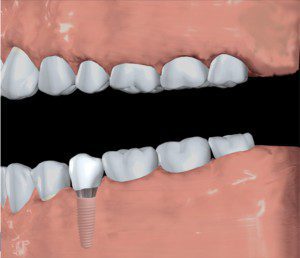You don’t need a three tooth solution for a single tooth problem.
By Dr. Joseph Farag –
 There is no doubt that when a tooth is lost due to infection, decay or trauma, many factors of oral health are affected. In addition to those factors, cosmetics may also be affected if a front tooth is lost. Common causes of tooth loss are decay, periodontal disease, failed root canal therapy, and traumatic injury. Modern dentistry has improved the chances of restoring these teeth to function but there are many cases when an extraction is the only option.
There is no doubt that when a tooth is lost due to infection, decay or trauma, many factors of oral health are affected. In addition to those factors, cosmetics may also be affected if a front tooth is lost. Common causes of tooth loss are decay, periodontal disease, failed root canal therapy, and traumatic injury. Modern dentistry has improved the chances of restoring these teeth to function but there are many cases when an extraction is the only option.
Options for the Loss of One or More Teeth
When a patient is faced with the loss of one or more teeth, modern dentistry can offer two options of non-removable “fixed” replacement. The first option is a fixed or cemented bridge; the second non-removable option would be a dental implant. Of course, the removable dentures and partial dentures remain as options, but these removable appliances are the least desirable by most patients. For the purposes of this article, we will only compare the differences between the non-removable options.
A Dental Bridge
The first most common replacement for a missing tooth or teeth is the dental bridge. A bridge can be made of metal, porcelain or a combination of the two. Bridges are designed from two main components, retainers (supporting teeth), and pontics (replacement teeth). The typical lifespan for a dental bridge ranges from 5 years on the low end to over 15 years on the higher end. Factors that can affect the life of a bridge are recurrent decay, periodontal disease (bone loss), and porcelain fracture. A bridge requires the reduction or reshaping of the supporting teeth which may not be such a problem for teeth that may already have a large filling or fracture. Although, when the adjacent teeth have never had a filling or do not have decay or fracture, a more conservative solution may be worth looking at.
Dental Implants
Dental implant therapy has improved dramatically since it was first offered to patients. Unfortunately, patients have a perception of dramatically higher cost and painful procedures when discussing dental implants. These perceptions need to be changed; in many cases the dental implant option to replace a single missing tooth is less expensive, less painful, and less complicated than an alternative three-unit bridge. Some of the advantages of placing a dental implant as opposed to a bridge are; no need to alter the remaining teeth, ease of flossing between teeth, preservation of remaining bone, and a more natural sensation of function.
The typical lifespan of a dental implant is longer than that of a bridge, since they are not vulnerable to decay which is the leading cause of dental bridge failure. When replacing a single missing tooth, a dental implant can add new support and restore complete function, whereas a bridge would use the existing dentition to support the replacement tooth.
To learn more or to schedule an appointment, please call Dr. Joseph Farag at Port Charlotte Dentalcare, 941-764-9555.







